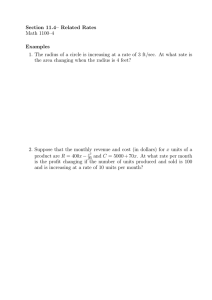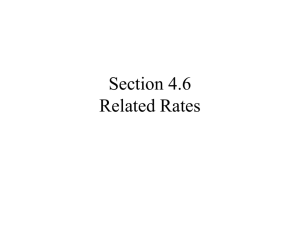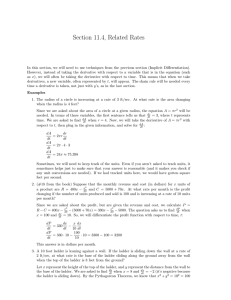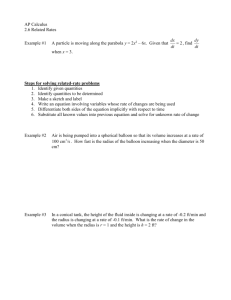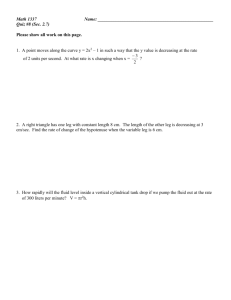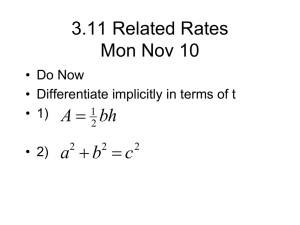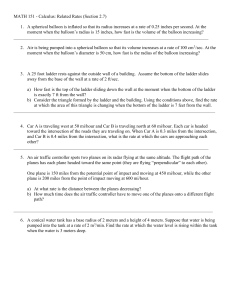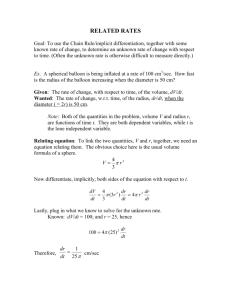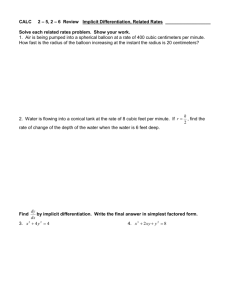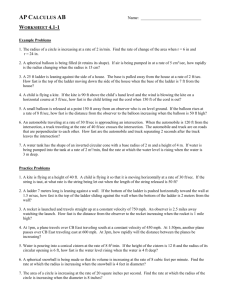related rates help
advertisement
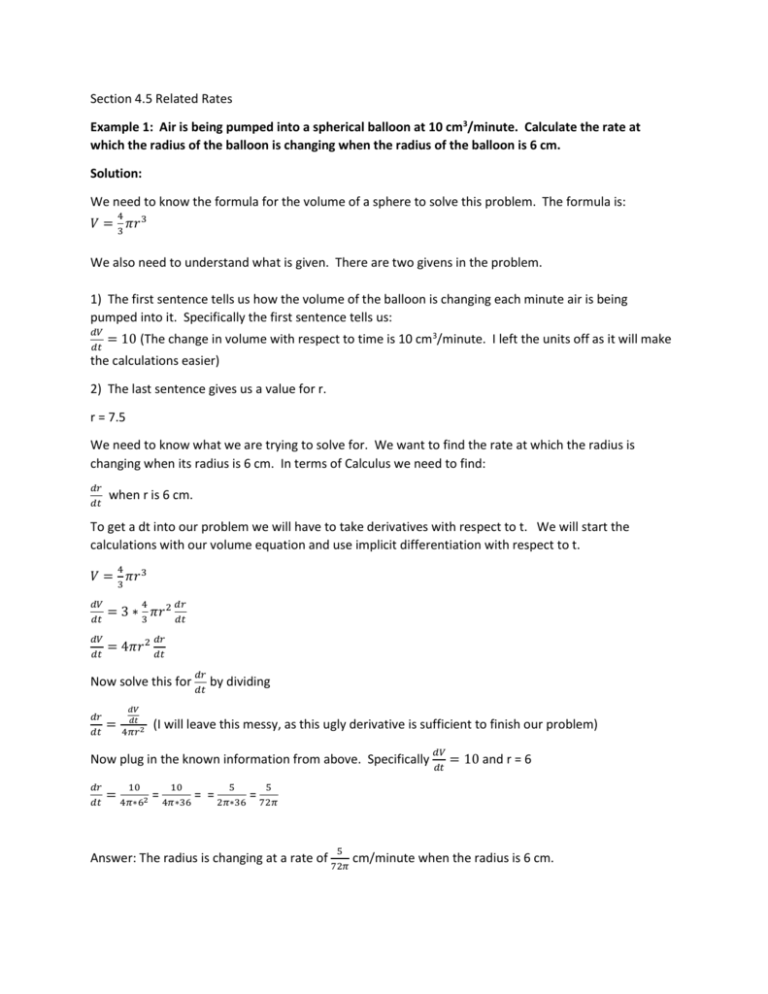
Section 4.5 Related Rates Example 1: Air is being pumped into a spherical balloon at 10 cm3/minute. Calculate the rate at which the radius of the balloon is changing when the radius of the balloon is 6 cm. Solution: We need to know the formula for the volume of a sphere to solve this problem. The formula is: 4 𝑉 = 3 𝜋𝑟 3 We also need to understand what is given. There are two givens in the problem. 1) The first sentence tells us how the volume of the balloon is changing each minute air is being pumped into it. Specifically the first sentence tells us: 𝑑𝑉 𝑑𝑡 = 10 (The change in volume with respect to time is 10 cm3/minute. I left the units off as it will make the calculations easier) 2) The last sentence gives us a value for r. r = 7.5 We need to know what we are trying to solve for. We want to find the rate at which the radius is changing when its radius is 6 cm. In terms of Calculus we need to find: 𝑑𝑟 𝑑𝑡 when r is 6 cm. To get a dt into our problem we will have to take derivatives with respect to t. We will start the calculations with our volume equation and use implicit differentiation with respect to t. 4 𝑉 = 3 𝜋𝑟 3 𝑑𝑉 𝑑𝑡 = 3 ∗ 3 𝜋𝑟 2 𝑑𝑡 4 𝑑𝑟 𝑑𝑉 𝑑𝑡 = 4𝜋𝑟 2 𝑑𝑡 𝑑𝑟 𝑑𝑟 Now solve this for 𝑑𝑡 by dividing 𝑑𝑟 𝑑𝑡 = 𝑑𝑉 𝑑𝑡 4𝜋𝑟 2 (I will leave this messy, as this ugly derivative is sufficient to finish our problem) Now plug in the known information from above. Specifically 𝑑𝑟 𝑑𝑡 10 10 5 𝑑𝑉 𝑑𝑡 = 10 and r = 6 5 = 4𝜋∗62 = 4𝜋∗36 = = 2𝜋∗36 = 72𝜋 5 Answer: The radius is changing at a rate of 72𝜋 cm/minute when the radius is 6 cm. Section 4.5 Related Rates Example 2: A 25 foot ladder is leaning against a wall and the top is sliding down the wall while the bottom is sliding away from the wall at 2 ft/sec. How fast is the top sliding when it is 9 ft above the ground? Here is a diagram that illustrates the problem. In this diagram x is the distance the base of the ladder is from the house, and y is how far the top of the ladder is from the ground. Specifically we know y = 9 for the 9 feet the ladder is on the wall, 𝑑𝑥 𝑑𝑡 = 2 𝑓𝑡/𝑠𝑒𝑐 as the base is moving away from the wall at a rate of 2 ft/sec 𝑑𝑦 we want to find 𝑑𝑡 I will also need a value for x. I need to create an equation to match up with my diagram. This is a right triangle, so I will use the Pythagorean Theorem. x2 + y2 = 25 Now I will take the derivative with respect to t. 𝑑𝑥 𝑑𝑦 2𝑥 𝑑𝑡 + 2𝑦 𝑑𝑡 = 0 Now solve the derivative for 2𝑦 𝑑𝑦 𝑑𝑡 𝑑𝑦 𝑑𝑡 = = −2𝑥 −2𝑥 𝑑𝑥 𝑑𝑡 2𝑦 𝑑𝑥 𝑑𝑡 𝑑𝑦 𝑑𝑡 𝑑𝑦 𝑑𝑡 = −𝑥 𝑑𝑥 𝑦 𝑑𝑡 𝑑𝑥 𝑑𝑥 I need to plug in values for x, y and 𝑑𝑡 . I know y = 9, 𝑑𝑡 = 2, but I don’t know x. I will need to find x before I can answer the question. I will use the Pythagorean Theorem from above and plug in y = 9. x2 + y2 = 252 x2 + 92 = 252 x2 + 81 = 625 x2 = 544 x =23.32 feet. 𝑑𝑥 𝑑𝑦 Now I will plug x = 23.32, y = 9, 𝑑𝑡 = 2 into the equation 𝑑𝑡 = 𝑑𝑦 𝑑𝑡 = −23.32 ∗2 9 −𝑥 𝑑𝑥 𝑦 𝑑𝑡 = 5.18 Answer: The top of the ladder is moving at a rate of 5.18 ft/sec. to get my answer.
